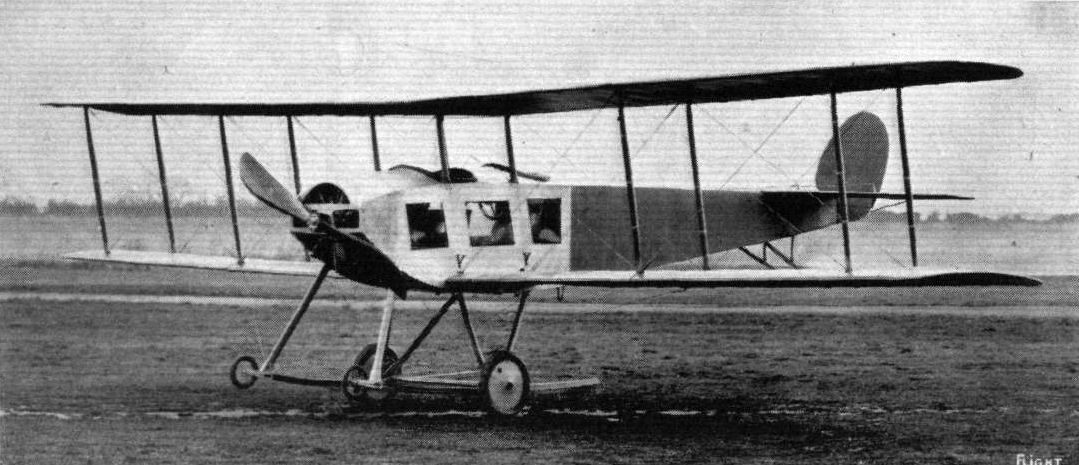M.Goodall, A.Tagg British Aircraft before the Great War (Schiffer)
Deleted by request of (c)Schiffer Publishing
SOPWITH Tractor biplane Type D (Originally known as the Three-Seater)
The first entry on 30 January 1913 in Sopwith's Order Book was for a three seater biplane developed from the 'Hybrid'. This was constructed with great urgency to be exhibited at the Olympia Aero Show opening on 14 February 1913. The machine was built in the Rink and was taken by road to Brooklands one week before the show opened. After brief tests by Sopwith and Hawker it was dismantled and dispatched to Olympia. After the show closed it was flown at Brooklands and then delivered to Hendon by a Naval pilot on 1 March 1913. The machine appears to have been accepted, although it was soon returned to the works for modification, nevertheless it was paid for on 20 March 1913, for a sum of . 1,085, and became serial No. 33. The aircraft saw service in Belgium and France, but was finally deleted on 14 October 1914.
Three more of the type were put in hand and two of these were covered by Admiralty Contract CP45488/13X11298, becoming Nos. 103-104, when delivered in September 1913. They were retained in use until September and January 1915 respectively. The third machine was retained by the firm until impressed in August 1914 as No.906. In its short service life it operated in France and Belgium and was used to attack airship sheds at Dusseldorf, before deletion in October 1914.
The War Office bought nine of the type for use by the Military Wing, which were ordered on 8 August 1913 and were delivered between November 1913 and January 1914. These were numbered 243, 246-247, 300, 315, 324-325 and 333. No.243 was tested to destruction at Farnborough and saw no active service.
The original Sopwith Tractor was built as a three seater, but it lost this identity when ordered by the Services, who had a requirement for two seats only. The machine had two bay wings with stagger; warping control was fitted initially to Nos.33 and 906, although ailerons were fitted to these later and to all the subsequent aircraft. The area and the gap were smaller than on the 'Hybrid', at the time when the fuselage had been lowered to the level of the bottom wing on that machine.
The undercarriage was simplified, the skids being shortened and small bumper wheels added. The first machine rested on the trailing portion of the main skids, although a double tail skid was fitted; later machines rested on a modified tail skid, probably due to the revision of the undercarriage and weight redistribution. The original balanced rudder with curved outline and area mainly above the fuselage, was superseded by one with a flattened shape, with the area equally distributed above and below.
No.104 was used by Hawker on 31 May 1913 to establish a British altitude record of 11,450 ft.
Power: 80hp Gnome seven-cylinder air-cooled rotary driving a 8ft 6in diameter Chauviere propeller.
Data
Span 40ft
Chord 6ft lin
Gap 5ft 3in
Area 365 sq. ft
Area tailplane/elevator 39sq ft
Area rudder 10 l/2sq ft
Length 29ft 6in
Weight 1,0601b.
Weight allup 1,810 lb. (3 seater)
Speed range 40.6-73.5 mph
Rate of climb 2 1/3 min to 1,000ft
Endurance 2 1/2 hr
Note. In addition to the newly-built aircraft listed, No.27, the 'Hybrid' was returned to the works for rebuilding. Entry No.21 in the Sopwith Order Book dated 5 August 1913, gives a price of .685 for the work. The aircraft left the Rink on 28 October 1913, and was delivered from Brooklands to Eastchurch by Harold Barnwell on 6 November 1913.
H.King Sopwith Aircraft 1912-1920 (Putnam)
'Three-seaters' and Derivatives
So it came about that on the occasion of the 1913 Olympia Aero Show, held in February of that year, the designation 'Sopwith Three-seater', jointly with that of ‘Bat Boat’, borne by Britain's first successful flying-boat, as later shown, removed the name and fame of ‘Sopwith' - the image as it would be termed today - from the sporting and promotional scene to that of original design and construction. It would, in fact, be hardly overstating the matter to declare that the 1913 Three-seater marked the true inauguration of the 'all-Sopwith' range of tractor landplanes and floatplanes, the lineage whereof will be traced through many pages to follow. More explicitly, the "hybrid' represented an archetype, whereas the design now under scrutiny was a prototype in the accepted sense.
Of even greater significance in a broader sense, the present writer would go so far as to proclaim the early-1913 Sopwith 'land tractor' (as it was sometimes called) as the true begetter of a line of British transport biplanes built - with notable success to a characteristic formula: that is, with the passengers in a forward fenestrated compartment, with the pilot behind them, and having no more engine-power than was strictly necessary to perform (jointly with generous wing-area) a rigorous operation with exemplary economy. The line of aeroplanes one has in mind came to full fruition in the well-nigh incomparable de Havilland series of the inter-war years, culminating in the little Fox Moth.
So evident, in any case, were the merits of Sopwith's new tractor that they were acclaimed even in their time - for pioneers and prophets pre-1914 went frequently unhonoured, even though meticulous records were supposedly maintained to chart aeronautical progress. So true was this last assertion that publication (for instance) of Octave Chanute's Progress in Flying Machines stood as a beacon on the very course it charted.
Less renowned than such a bible - and less well-known even than Flight or The Aeroplane - was the English journal Aeronautics which, in August 1913, made this declaration: If one were asked to give the name of the most successful machine in existence, at least one of British design and construction would be among the claimants for place among those for final selection. How many constructors would undertake to build a machine which, when fitted with an 80-h.p. Gnome, is satisfactorily capable of carrying pilot and two passengers in addition to four hours' fuel? The Sopwith biplane can accomplish this and, at the same time, fly within a wide range of speed. This range, naturally, is not so great as the range obtained when the standard load of three hours' fuel and one passenger is carried, but reasonably large nevertheless." Having mentioned also the Bat Boat, the journal continued: 'The Sopwith Aviation Co. have undertaken an enormous amount of work, and though this fact might have tended to cause a lack of thoroughness in the firm's productions, no trace of this is visible.'
As exhibited at Olympia in February 1913 the Three-seater differed very noticeably from its hybrid precursor bearing, in fact, much the same relationship to it as did the Avro 504 of 1913 to the Avro Type D of 1911. Staggered wings were only one of its identifying features. The tail and landing gear were altogether new, and most striking of all the novelties - three big non-inflammable celluloid panels were let in to each side of the forward fuselage, to improve the downward-and-sideways (and in some degree forward) field of view for the three occupants.
One contemporary assessment tantalisingly invited elucidation. This was to the effect that the new machine was 'similar to the one recently supplied to the Admiralty' (meaning, presumably, the hybrid) - excepting that it had staggered wings and an 80 hp Gnome engine (instead, it was implicit, of a 70 hp unit of the same type). Clearly, though, here was a machine calling for detailed study even in its day, and even more so on this present occasion. Thus may history be honoured, and today's investigations be satisfied, by the following first-hand appraisal:
'Staggered planes are used, and these appear to be of such a camber as would permit the machine to be of an exceedingly fast description. An 80-h.p. Gnome is fitted in front, driving a tractor propeller.' (Present writer's note: Clearly, the observer under quotation wished to impress on his readers that this aeroplane was of tractor form, though in order to acquit him from naivety or tautology it must be recalled that certain types of the period had the engine in front, though driving a pusher propeller. The Mersey Military Trials Monoplane of 1912 was a case in point, likewise the Grahame-White Type 6 Military Biplane - exhibited at Olympia in 1913, as was the Sopwith now reviewed). To continue the contemporary appraisal under quotation:
'The main chassis consists of a pair of wheels mounted on what may best be described as a V inclined forward, while a pair of smaller wheels are mounted on another pair of struts in front. The whole strikes one as being amply qualified for resisting any shock, within limits, to which it may be subjected, and the fitting of an additional and non-weight-carrying pair of wheels forward has found favour in certain quarters, on account of its tendency to prevent any possibility of the machine's complete inversion should a somewhat steep landing be made. The interplane struts situated at the point where the planes abut upon the fuselage, and the fuselage uprights, are one and the same member - this naturally reducing weight and head resistance to a considerable extent.
'The reduction of these two bugbears, in fact, has obviously been the end and aim of the designers. Their efforts to minimise the former can be seen everywhere and are distinctly worthy of emulation. In almost every instance, not only in fuselage longitudinals and uprights and in the ordinary struts, but even in the thin members which support the fabric in the various members of the tail, has weight been brought down by channelling to what in some cases almost approaches an I section. In other cases, where this method of procedure has been impossible, the spars and struts are built up hollow, the centre being flat and composed of ash, and surrounded on each side by a curved section of spruce. They are bound at intervals with oil-silk ribbon. The lightness of the spars is astonishing, while their rigidity and strength should leave nothing to be desired. It is interesting to note that the ash centres of the main spars are of approximately the same-sized section as that of the wing-spars on the standard 70-h.p. Bleriot, though in the latter case they are not strengthened by spruce coverings! This is another instance of the fact that, though the reduction of unnecessary weight has been one of the chief aims of the designers, this has not been accomplished at the expense of the strength of parts. One may at first question the necessity of drilling eighteen to twenty holes in a steel clip which is only five inches by about two or three inches in dimensions, for the weight of a single example cannot be greatly reduced thereby, but one realises eventually that, if this is done to every clip upon the machine, the desired effect is produced to a considerable extent. Sonic of the clips are really the most remarkable that the writer has yet seen, representing as they do the outcome of most thoughtful design, while the labour and expense that must necessarily have been involved is by no means inconsiderable. The most remarkable of these clips is a socket which holds no fewer than four members, viz, the main-plane spar, the inter-plane strut, the fuselage upright, and one of the undercarriage struts! Even the small clips for attaching the fuselage uprights and longitudinals together are carefully drilled, and are of the pattern introduced by the Hanriot Company, i.e., are actually clipped to the wood by compressing it, no bolts in consequence piercing it.
'A novel and extremely laudable point is the employment of steel tube for the trailing edge and extreme tips of the planes. This, in the latter case, permits the camber to extend right up the whole length of each wing, which fact must obviously give greater efficiency. The struts for the undercarriage are also constructed of steel, though in this case they are of 18-gauge steel plate bent into a tube of marvellous sections.
'One point which will undoubtedly pass unnoticed by the majority of those who examine the tractor-biplane is not really of any great structural importance, though it shows the care which has been devoted to the small details of design, and will be appreciated by those who have to make any adjustments or alterations to that part of the machine referred to. The tail-plane, as mentioned, has its outer framework constructed of steel tube, the latter being attached to the longitudinals by U-bolts. The minor, though all-important feature of this attachment, however, is that the bolt is kept from falling out when the nuts on its top extremities are loosened.'
The general conclusion was that the two new Sopwiths - the Three-seater landplane and the Bat Boat pusher flying-boat-represented 'the last word' in aeroplane construction. Yet conservatism lingered, and lateral control on both machines was by wing-warping, the warping pulleys being ingeniously combined with the rear-spar hinges, and actuated by a warp-wheel on a vertical 'elevator column'. Ailerons came later, on developed versions; and certainly by August 1913 there were at Brooklands 'two Sopwith tractor biplanes-one fitted with warping wings and the other with ailerons."
'Last word' or not, it was the 1913 Three-seater that not only put Sopwith in business as an aircraft constructor in general, but, in particular, as a supplier to the Services; for more or less coinciding with the Olympia exhibition of February 1913 (the displayed example having already been tested by Sopwith himself, and shown to be capable of over 70 mph) came orders for two Naval specimens of the same general type. The show-machine itself, in fact, was actually the first to be delivered to the Navy, the pilots to whom it was handed over on 1 March, 1913 – being that breezy pair Lieuts Spenser Grey and L'Estrange Malone. To this same aeroplane the Service number 103 was allocated, and Spenser Grey, with Lieut Bigsworth as passenger, was reported as having looked in at Hendon with the 'Naval 80 hp Sopwith Tractor' on 24 May.
During May also Harry Hawker flew the Navy's No. 104 to Farnborough, to demonstrate for the War Office such useful attributes as a speed range of 35-75 mph. As Aeronautics had already noted, the standard load (for Service use, certainly) was one passenger only, with fuel for three hours; and it was assuredly not as a three-seater that No. 104 was to be found at Eastchurch in January 1915 on 'Zeppelin stand-by".
Nor was the prewar public in ignorance of the (nominally) Three-seater's capabilities: for with Hawker as pilot, an aircraft of the type won the Cross-country Race at Brooklands on Whit-Monday 1913, then climbed to 7.500 ft in 15 min. Whereafter things got better still, for on 31 May the 'great Harry' set a (solo) British height record of 11.450 ft.
Matters then progressed from excellent to better still, for on 16 June Hawker look a single passenger to a breath-taking 12,900 ft, and on that same day (half an hour later, in fact) carried two passengers to 10,600 ft. Even with three men, in addition to his slender self, he managed 8,420 ft - on 27 July, 1913.
Nevertheless the Sopwith Tractor Biplane (potential seating capacity going unacknowledged) was chiefly used not for passenger transport, but as a general-duties two-seater, by both the RNAS and the RFC.
Cannibalisation - as the term was to become current in air-service jargon - was rife, as was modification; and certainly distinctive in this regard was the second example constructed (or reconstructed) for this had a deeper fuselage and windows with rounded corners.
The transformation from three-seater to two-seater must not be passed over without noting a clear intention that a military application was foreseen for the former layout. Thus a contemporary declaration: 'The machine is arranged to seat three, two observers side by side at the centre of gravity, and the pilot some little distance behind them. The bottom plane being staggered back by 1 ft, the observers are able to obtain a good view of all that is happening below them. The pilot can get a good view below him too, for the trailing edges of the planes on either side of him are cut away for that purpose.'
For the shapely Olympia-pattern rudder a more angular form was substituted, reminiscent of the earlier hybrid in that the area was distributed above and below the fuselage. But still there was no fin. For competition work, and Service testing also, a 100 hp Green water-cooled engine was fitted experimentally, and in this instance an Integral propeller, instead of a Levasseur or Chauviere, was tried. The petrol tank (on a typical Three-seater, at least) was under the passengers' seat.
Although passing references have already been made to the landing gear, it must now be stressed that the agglomeration of struts, wheels and skids tended to obscure one particular feature that was eventually incorporated that is, the so-called 'split axle’, which was to become almost a Sopwith trademark on the later and better-known war machines (a design with each wheel mounted on a half-axle, the inner ends whereof were pivoted at the mid-points of the spreader-bar, or bars). There were, in fact several variations in landing gear, notably with two massive tailskids; but the following description appears to have applied early in 1913:
'The landing chassis is of the combined wheel and skid type. The body of the machine is supported from two long hickory skids by six spruce struts. The two pairs of rear struts are assembled to the skid by a welded steel fitting which is also slotted to take the axle of the two landing wheels. The latter are strapped with rubber cords to the skids. Miniature skid-tip wheels are fitted. They are 13 ins. in diameter, and are each supported by a pair of beaten steel fittings. The main skids, the sides of which are hollowed out for lightness, are continued back 3 ft. or so behind the rear chassis struts, in such a manner that there is no necessity to provide a rear tail skid. These continuations of the rear skids have the advantage that they act as most efficient land brakes when it is required to pull the machine up quickly
Apart from Nos.103 and 104. already mentioned as going to the Navy, that same Service had No.906 (after it had served as Sopwith's hack and demonstrator) and other recorded numbers for these Sopwith Tractors were 248, 315, 319, 324 and 325 all these for the RFC. That cannibalism and modification was rife in respect of these biplanes has already been observed, and even the number built remains open to question, though in September 1913 it was reported, apparently with good authority, that: 'The Sopwith Co at Kingston continues to test its many machines at Brooklands before their delivery to the two Services. Nine 80-h.p. tractor biplanes, standard type [sic] were recently ordered for the Army, while delivery of two was requested by the Admiralty." The inference was rightly drawn that 'these two sets of orders are only the beginning of a long period of prosperity for Messrs Sopwith' - rightly, that is, if one reckons the 1914-18 war and its immediate aftermath as 'long'.
Before the coming of that war the great event for the Royal Flying Corps (Military Wing) was, of course, the 'Concentration Camp' at Netheravon the description having no sinister implication, but being analogous with the Naval Review, or mustering, of the same period. Respecting the 'M.W.' camp, I have examined a duplicated typed sheet once possessed by the Camp Commandant himself. Pencilled-in, and detailing one particular 'task for aircraft', could be perceived - after the listing of Bleriots, Farmans and B.E.s - the addition '& Sopwiths".
Two or three years later a typical RFC Order of Battle might have listed 'Sopwiths (& other types)'. Need more be said?
'Three-seater' (as at early 1913) (80 hp Gnome)
Span 40 ft (12.2 m); length 29 ft 6 in (9 m); wing area 365 sq ft (33.9 sq m). Empty weight 1.100 lb (500 kg); maximum weight 1,750 lb (790 kg). Maximum speed 70 mph (112 km/h). Climb 500 ft/min (152 m/min); ceiling (with one passenger) 12,900 ft (3,930 m).
P.Lewis British Aircraft 1809-1914 (Putnam)
Sopwith Three-seater
Outstanding among the new aeroplanes exhibited at the 1913 Olympia Aero Show was the Three-seater, the first of the long series of Sopwith tractor biplanes. Designed by T. O. M. Sopwith and F. Sigrist, the machine represented a distinct advance towards rational and practical aircraft and, together with its Avro and Bristol contemporaries, played its part in establishing the classic British formula which was adhered to for the next two decades.
The Three-seater carried its complement of two passengers side-by-side in the front cockpit below the centre-section of the wing, the pilot occupying a separate cockpit immediately to the rear. A praiseworthy feature of the design was the provision, on each side of the fore-fuselage, of three large celluloid panels for improved downward vision. The main undercarriage consisted of a pair of normal vee-struts combined with two skids embodying a small wheel at the front of each. Unusual was the fitting of twin tail-skids the width of the fuselage apart. The two-bay wings were slightly staggered and had warping tips, but no fin was installed.
After its emergence, the 80 h.p. Gnome Three-seater was straightaway demonstrated at flying meetings by H. G. Hawker, Sopwith's test pilot. On Whit-Monday, 1913, the machine came first in the Cross-country Race at Brooklands and was then taken by Hawker to a height of 7,500 ft. in 15 mins. Thereafter, the same pilot proceeded to demonstrate the aircraft's capabilities with several record-breaking climbs. At Brooklands on 31st May, 1913, he went to a new British solo height of 11.450 ft. Two weeks later, on 16th June, Hawker took one passenger up to 12,900 ft., and later on the same day reached 10,600 ft. with two passengers on board. On 27th July, 1913, Hawker and three passengers ascended to 8,400 ft. Later in the year he used a modified version fitted with a 100 h.p. Green engine for attempts on the British Michelin Cups Nos. 1 and 2, but without success.
The Three-seater was ordered by the R.F.C., followed by the R.N.A.S., a total of nine being delivered for Service use. These were normally flown as two-seaters only, some of them being aileron-equipped, and the small wheels on the skids were omitted on a few. The Service machines differed also in having rudders of a modified outline. Before the outbreak of war, No. 5 Squadron, R.F.C., was flying Three-seaters, and they were employed later by Commander Samson's Eastchurch Squadron and for coastal patrol from Great Yarmouth.
SPECIFICATION
Description: Three-seat tractor biplane. Wooden structure, fabric covered.
Manufacturers: Sopwith Aviation Co. Ltd., Kingston-on-Thames, Surrey.
Power Plant: 80 h.p. Gnome, 100 h.p. Green.
Dimensions: Span, 40 ft. Length, 29 ft. Wing area, 365 sq. ft. Weights: Empty, 1,000 lb. Loaded, 1,750 lb.
Performance: Maximum speed, 70 m.p.h. Climb, 500 ft./min. Ceiling, 12,900 ft. Endurance 4.5 hrs.
Price: ?1,185.
J.Bruce British Aeroplanes 1914-1918 (Putnam)
Sopwith Tractor Biplane (80 h.p. Gnome)
THE first Bat Boat shared the Sopwith stand at the 1913 Aero Show with a handsome and workmanlike tractor biplane, powered by an 80 h.p. Gnome rotary engine. In its display form this Sopwith machine had seats for the pilot, who occupied the rear cockpit, and two passengers who sat side-by-side in front. Three large transparent panels let into each side of the fuselage ensured good downward view for all occupants.
The engine was installed in a nose-bearing mounting and was simply and effectively cowled. The undercarriage was a sturdy affair, with horizontal skids each of which had a small auxiliary wheel at its forward end. An unusual design feature was the use of twin tail-skids.
The two-bay wings had slight stagger and were braced by cables. Lateral control was by wing-warping. A semicircular tailplane with divided elevators was fitted, and an oval rudder was used; its axis was slightly set back in order to provide a small balancing area. There was no fin. Later, a larger rudder was fitted; it was roughly rectangular in shape and extended both above and below the fuselage.
Like the Bat Boat, the new three-seater made a good impression, and the Admiralty ordered two of the type. The first was delivered to Hendon by Lieutenant Spenser D. A. Grey, R.N., with Lieutenant l’Estrange Malone as passenger. Several of the type were built for the R.F.C., and were used by both Military and Naval Wings.
The achievement for which the Sopwith three-seater is best remembered is its fine performance in May, June and July, 1913, when, flown by Harry Hawker, it set up new British altitude records in four categories. Without a passenger, Hawker reached 11,450 feet on May 31st; on June 16th he climbed to 12,900 feet with one passenger, and to 10,600 feet with two; and on July 27th he flew the same machine to 8,400 feet with three passengers. This last flight constituted a new world’s record. The names of Hawker and the Sopwith three-seater were prominent in several pre-war flying events.
In the contest for the British Empire Michelin Cup, Hawker flew a modified version of the three-seater which had a 100 h.p. Green engine to make it all-British. His two attempts were dogged by his ill-health and bad weather.
The later machines delivered to the R.F.C. were usually flown as two-seaters. Some had ailerons for lateral control, and the small wheels were removed from the forward ends of the skids. The R.N.A.S. had six Sopwith biplanes with 80 h.p. Gnome engines when war broke out.
When the Eastchurch Squadron of the R.N.A.S. went to France on August 27th, 1914, it took with it two Sopwith biplanes of the basic three-seater type. They did not survive for long: by mid-September only one remained, and was not on the strength of the unit later in the year.
A few went to Great Yarmouth R.N.A.S. Station, where they were used for patrol duties for a short time until written off in forced landings.
Although its war career was brief and undistinguished, the Sopwith biplane gave the first real indications of what could be done by a well-designed biplane, indications which were quickly realised in the Tabloid.
SPECIFICATION
Manufacturers: The Sopwith Aviation Co., Ltd., Canbury Park Road, Kingston-on-Thames. Power: 80 h.p. Gnome; 100 h.p. Green.
Dimensions: Span: 40 ft. Length: 29 ft. Stagger: 12 inches. Airscrew diameter: 8 ft 6 in. Areas: Wings: 365 sq ft.
Weights: Empty: 1,100 lb. Loaded: 1,550 lb.
Performance: Maximum speed at ground level: 70 m.p.h. Climb to 7,500 ft: 15 min. Ceiling: 12,900 ft.
Armament: None.
Service Use: Pre-war: No. 5 Squadron, R.F.C.; R.N.A.S. Station, Eastchurch. War-time: Western Front, R.N.A.S., Dunkerque; Coast Patrol, R.N.A.S., Great Yarmouth.
Serial Numbers: 33, 103, 104, 160.
O.Thetford British Naval Aircraft since 1912 (Putnam)
SOPWITH D.1
This biplane, which seated two passengers side-by-side in the front cockpit and the pilot in the rear cockpit, appeared at the same time as the Bat Boat in 1913. It was adopted by both the Naval and Military Wings of the RFC, and on the outbreak of war in 1914 the RNAS had two, Nos.l03 and 104. They flew from Eastchurch and Calshot and on patrols from Scapa Flow. One 80 hp Gnome engine. Loaded weight, 1.550 lb. Span, 40 ft. Length, 29 ft.
Jane's All The World Aircraft 1913
SOPWITH. Sopwith Aviation Co. Works: Canbury Park Road, Kingston-on-Thames. School: at Brooklands. Established by T.O.M. Sopwith, the well-known aviator at Brooklands, Autumn of 1911, where during 1912, a 70 h.p. tractor biplane and a 40 h.p. biplane was turned out.
Floor area of the Kingston works in March, 1913, was 30,000 sq. ft. with electric power plant. Works manager: F. Sigrist. General manager: R.O. Cary. Output capacity: at full pressure about 50 machines a year.
1913. 1913. 1913. 1913.
Bat boat Tractor School Armoured
hydro biplane biplane. warplane.
biplane 3-seater
Length......feet(m.) 30-1/3 (9.20) 29 (8.85) 9 (8.85) 29' 7?" (9)
Span........feet(m.) 41 (12.50) 40 (12.20) 40 (12.20) 50 (15.25)
Area.....sq.ft (m?.) 422 (39) 365 (34) 400 (37) 552 (51)
Weight,
total...lbs.(kgs.) 1700 (771) 1750 (794) 1200 (544) 2000 (907)
useful..lbs.(kgs.) 500 (227) 750 (340) 400 (181) 800 (362)
Motor......... h.p. 90 Austro- 80 Gnome 50 Gnome 90 Austro-
Daimler Daimler
Speed,
max...m.p.h.(km.) 65 (105) 74 (125) 48 (78) 65 (105)
min.. m.p.h.(km.) 42 (68) 40 (65) 35 (60) 38 (61)
Endurance........hrs. ... ... ... ...
Notes.--Wood construction. Carriage wheels and skids. Control: balanced ailerons.
Журнал Flight
Flight, February 8, 1913.
WHAT THERE WILL BE TO SEE AT OLYMPIA.
THE MACHINES.
The Sopwith Aviation Co.
<...>
The Sopwith Co.'s second machine will be a tractor biplane, similar to the one they have supplied to the Admiralty, fitted with an 80-h.p. Gnome. It is a three-seater, two observers being accommodated side by side, well forward on the body, where they have a good view. The pilot sits behind them. Control in the case of both machines is operated by a warp wheel, mounted on a vertical elevator column. Steering is done by a foot-bar.
Flight, February 15, 1913.
SOPWITH AVIATION CO.
Two biplanes, one a hydro-biplane and the other constructed for land work, represent the Sopwith Co. on Stand 22. Both were designed by, and the construction carried out under the supervision of, Mr. T. O. M. Sopwith and his works manager, Mr. F. Segrits, at the Company's works at Kingston-on-Thames. They are no freak machines, these two biplanes of Sopwith's, a rough glance over them will soon convey to the observer that they are designed by practical men. Of the two, the hydro, is the more interesting since it is the more original.
<...>
The 80-h.p. Sopwith Tractor Biplane. - a similar machine to the one recently supplied to the Admiralty, excepting that the machine has staggered planes, and is fitted with an 80-b.p. Gnome motor.
Its fuselage is of the ordinary lattice girder type, built up with ash longitudinals, and cross and vertical struts of spruce, all of which are spindled down to to an I section wherever possible for lightness sake. The sockets, by which they are assembled, are cut from mild steel, and shaped so that they wrap the longitudinal members, a method by which drilling of the spars and consequently weakening them, is avoided.
The motor, a 80-h.p. Gnome, is mounted in front by bearers on either side of the crank-case. It is direct coupled to a Levasseur propeller, 8 ft. 6 ins. in diameter. A metal cowl covers the top half of the engine, so preventing any oil or exhaust fumes reaching the people on board.
The planes are almost identical with those of the hydro-biplane we have just described, excepting that in the tractor biplane the top plane is staggered 1 ft. in advance of the lower one. Similar built-up spars and struts are used in both machines. For facility of transport the planes can quickly be dismantled in two sections. The end section of the rear span on either side of the machine is hinged to the rigid central section so that the warping may be operated without any internal strain occurring in the wing construction.
The landing chassis is of the combined wheel and skid type. The body of the machine is supported from two long hickory skids by six spruce struts. The two pairs of rear struts are assembled to the skid by a welded steel fitting which is also slotted to take the axle of the two landing wheels. The latter are strapped with rubber cord to the skids. Miniature skid-tip wheels are fitted. They are 13 ins. in diameter, and are each supported by a pair of beaten steel fittings. The main skids, the sides of which are hollowed out for lightness, are continued back 3 ft. or so behind the rear chassis struts, in such a manner that there is no necessity to provide a rear tail skid. These continuations of the rear skid have the advantage that they act as most efficient land brakes when it is required to pull the machine up quickly on landing.
The tail is semi-circular in shape and has a radius of 5 ft. As in the hydro-biplane, the skeletons of all the tail organs are constructed from steel tubing.
The machine is arranged to seat three, two observers side by side at the centre of gravity of the machine, and the pilot some little distance behind them. The bottom plane being staggered back, the observers are able to obtain a good view of all that is happening below them. The pilot can get good view below him, too, for the trailing edges of the planes on either side of him are cut away for that purpose. The Sopwith works have a very neat method of forming an eye with stranded steel cable. It is not an entirely original method, as the writer has noticed it on a number of other machines, especially in France. However, since it has not yet been described in these pages, it may be as well to mention it now. The cable is well cleaned, and on it is threaded a flattened tube of very soft copper. Then the cable is turned back, forming a loop, and in the loop is placed an eye. The copper tube is then slipped up, over the loose cable end until it is tight against the eye. It is then twisted several times, and finally the whole job is sweated up together.
Petrol is carried on this machine, in a tank under the passenger's seat. From there it is fed under pressure to a service tank arranged below the motor cowl. Weighing 1,100 lbs. light, this Sopwith biplane, has been designed to carry a useful load of 450 lbs. at a speed of from 65 to 70 miles per hour.
Flight, June 7, 1913.
BRITISH NOTES OF THE WEEK.
New British Height Record.
OF the flying seen at Brooklands last Saturday, the outstanding performance was, of course, the splendid climb made by Mr. H. G. Hawker, on the Sopwith tractor biplane. The conditions were by no means favourable, but the 80-h.p. Gnome stuck gamely to its task until a height of 11,450 ft. was shown by the barograph when the carburettor froze and Mr. Hawker was obliged to descend. The return to earth in a spiral vol plane only occupied 8 mins. The previous record was Lieut.de Havilland's 10,500 ft., which still remains the British record for pilot and one passenger.
Flight, September 20, 1913.
THE AERIAL DERBY.
PILOTS AND HOW TO RECOGNISE THE MACHINES.
No. 9. The Sopwith Biplane
resembles the Avro, but has a different landing chassis, as comparison of the accompanying silhouettes will show.
THE MACHINES, WITH SOME DETAILS.
No. 9. The 80 h. p. Gnome-Sopwith tractor biplane is somewhat similar to the Avro, and is fitted with an exactly similar engine. It is a very fast machine, and a splendid climber. Mr. Hawker's magnificent flight on a similar machine gave a better idea of its flying properties than could many words. The planes have a distinct dihedral angle, and span 41 ft.
Flight, March 26, 1915.
EDDIES.
For the space of a few minutes it was quite like old times up at Hendon on Saturday last, when Hawker, who had arrived from "somewhere" on a new Sopwith two-seater tractor biplane, circled the course several times, banking round the pylons in a way to gladden the hearts of everyone who appreciates skilful piloting. Later in the afternoon Hawker gave another demonstration of his art by taking the big Sopwith gun-'bus out for several circuits over the surrounding country. His handling of this machine was simply superb, everyone looking on in amazement. Some even began to figure out that it must be an entirely new machine, as it had never before been known to fly at such a speed, or to climb so steeply, or to do such sharp banked turns. But it wasn't - it just meant that Hawker is able to bring out the very best points of a machine, and to get out of it every ounce that it is capable of. At one time Hawker on the Sopwith gun-'bus and Mr. de Havilland on the De H. I., were flying almost side by side, their speeds seeming practically even, and as the De Havilland does over 70 miles an hour, the speed of the Sopwith - when piloted by Hawker - must be pretty well the same.
Flight, November 12, 1915.
CONSTRUCTIONAL DETAILS.-X.
<...>
In the Sopwith undercarriage illustrated the same simplicity prevails. Here, however, the axle is divided in the centre, where it is pivoted between the two transverse members joining the apexes of the chassis struts. In order to prevent a downward movement of the centre of these members a single wire is taken from this point to the bottom of the body. Transverse rigidity is established by diagonal cross bracing between the front pair of chassis struts as shown in the sketch. This undercarriage, it should be pointed out, is not that fitted as standard on the Sopwith scouts. It was, in fact, quickly produced for the last Aerial Derby, the original chassis of these machines being of the double-skid type. Since then other types have been experimented with, among these being one with no shock absorbers, but having wheels fitted with large diameter pneumatic tyres.
<...>
 |
Журнал - Flight за 1913 г.
|
| The 80-h.p. Sopwith tractor biplane.
|
 |
H.Cowin - Aviation Pioneers /Osprey/
|
| The Sopwith Three Seater of 1913 was an impressive performer, with the power of its 80hp Gnome setting a number of British altitude records in June and July 1913, in the hands of the by then Sopwith Chief Test Pilot, 'Harry' Hawker. Of these the highest reached was 12,900 feet with one passenger. The Three Seater could carry a 450lb payload at 70mph. At least seven of these machines were known to have been operated by the naval wing of the RFC.
|
 |
Jane's All The World Aircraft 1913 /Jane's/
|
| 1913. Tractor biplane.
|
 |
H.King - Sopwith Aircraft 1912-1920 /Putnam/
|
| A particularly pleasing aspect of the original Three-seater - bespeaking its excellent performance and carrying capacity using relatively low power.
|
 |
J.Bruce - British Aeroplanes 1914-1918 /Putnam/
|
| Sopwith Tractor Biplane with the larger rudder.
|
 |
H.King - Sopwith Aircraft 1912-1920 /Putnam/
|
| Three seats and twin skids (the latter in respect of main landing gear and tail-protection likewise) characterised the finest of the new line of Sopwith tractor biplanes, represented here tail-up and tail-down in the latter instance with modified rudder and other alterations (especially affecting the windows).
|
 |
M.Goodall, A.Tagg - British Aircraft before the Great War /Schiffer/
|
| Sopwith tractor biplane Type D originally referred to as the 'Three-seater'. The prototype flew in February 1913 and became No.33 with the RNAS.
|
 |
Журнал - Flight за 1913 г.
|
| The Sopwith.
|
 |
H.King - Sopwith Aircraft 1912-1920 /Putnam/
|
| Viewed close at hand, this particular Three-seater displays the nose-bearing mounting for the Gnome engine, and was used by the Navy, generally, one may suppose, as a two-seater, though Sir Thomas Sopwith once said that the first '3-seater tractor' he supplied to the Navy (possibly meaning the 'hybrid') was used to collect oysters for the officers' mess at Eastchurch.
|
 |
Журнал - Flight за 1913 г.
|
| The penalty of popularity. Mr. Hawker on the Sopwith-Tractor having his picture taken at Hendon.
|
 |
M.Goodall, A.Tagg - British Aircraft before the Great War /Schiffer/
|
| Sopwith Type D, in service with the Military Wing in 1913-1915, was used only as a two-seater.
|
 |
Журнал - Flight за 1913 г.
|
| THE BRITISH HEIGHT RECORD. - Mr. Hawker on the Sopwith tractor at Brooklands.
|
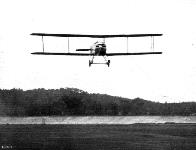 |
Журнал - Flight за 1913 г.
|
Brooklands track - familiar in so many views of Sopwith and Hawker aeroplanes - stretches ribbon-like across this study of a Three-seater.
The Sopwith tractor coming straight ahead at Brooklands with Mr. Hawker, who has just made a new height record, at the wheel.
|
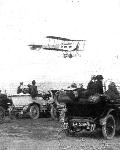 |
Журнал - Flight за 1913 г.
|
| SUNDAY FLYING AT BROOKLANDS. - Mr. H. Hawker giving a fine exhibition of his skill on the 80 h.p. Sopwith tractor.
|
 |
Журнал - Flight за 1914 г.
|
| AT BROOKLANDS. - Mr. Hawker in flight on the Sopwlth Tractor during the past season.
|
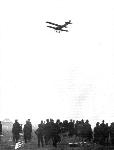 |
Журнал - Flight за 1913 г.
|
| Arrival, during the Model Flying Competition at Hendon, of Lieut. Spencer Grey on the Sopwith biplane.
|
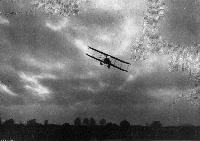 |
Журнал - Flight за 1913 г.
|
| AN EVENING FLIGHT AT BROOKLANDS. - A turn on the Sopwith tractor.
|
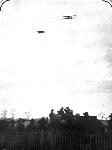 |
Журнал - Flight за 1913 г.
|
| Biplane versus monoplane in the Easter Aeroplane Handicap for the Shell prize at Brooklands on Easter Monday. - Mr. Barnwell, on the Vickers monoplane, passes Mr. Hawker, on the Sopwith, in the first lap.
|
 |
Журнал - Flight за 1915 г.
|
| The finish of an hour's Admiralty test. Mr. Hawker returning to Hendon on a Sopwith tractor.
|
 |
H.King - Sopwith Aircraft 1912-1920 /Putnam/
|
Commander Samson's Eastchurch Squadron of the RNAS at Dunkirk in 1914. The aeroplanes are (left to right): Henry Farman F.20. Samson's B.E.2a (No.50). Sopwith Tractor Biplane and Short No.42.
Betrayed - or proclaimed by its windows, though distant in this Farman/B.E./ Short Astra-Torres gathering, is a Sopwith tractor biplane of the 'Three-seater' family.
|
 |
Журнал - Flight за 1914 г.
|
| Mr. Victor Mahl, who has just secured his pilot's certificate on a Sopwith machine. It will be remembered Mr. Mahl was the mechanician who assisted Mr. Howard Pixton recently during his flight at Monaco in connection with the Schneider Cup, & c.
|
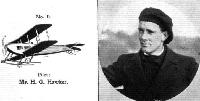 |
Журнал - Flight за 1913 г.
|
| Pilot: Mr. H. G. Hawker.
|
 |
P.Lewis - British Racing and Record-breaking Aircraft /Putnam/
|
| H. G. Hawker with the Sopwith Three-seater, flown to set several height records during 1913.
|
 |
Журнал - Flight за 1914 г.
|
| Lieut. Spencer Grey flying the new Sopwith biplane at Hendon. From an original drawing by Roderic Hill.
|
 |
Журнал - Flight за 1915 г.
|
|
|
 |
Журнал - Flight за 1913 г.
|
| The 80-h.p. Sopwith tractor biplane.
|
 |
Журнал - Flight за 1913 г.
|
| The 80-h.p. Gnome-Sopwith tractor biplane.
|
 |
Журнал - Flight за 1913 г.
|
| Details ol the Sopwith wing construction,
|
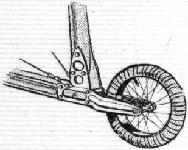 |
Журнал - Flight за 1913 г.
|
| Mounting of the skid tip wheels of the Sopwith tractor biplane.
|
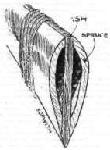 |
Журнал - Flight за 1913 г.
|
| Sketch showing the hollow construction of a Sopwith strut.
|
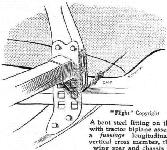 |
Журнал - Flight за 1913 г.
|
| A bent steel fitting on the Sopwith tractor biplane assembling a fuselage longitudinal, the vertical cross member, the rear wing spar and chassis strut.
|
 |
Журнал - Flight за 1913 г.
|
| The warping pulley of the Sopwith tractor biplane, showing how the same fitting is combined with the rear spar hinge.
|
 |
Журнал - Flight за 1913 г.
|
| Details of the chassis suspension of the Sopwith biplane as seen from above.
|
 |
Журнал - Flight за 1913 г.
|
| Diagram illustrating how stranded cable terminals are made on the Sopwith biplane.
|
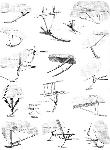 |
Журнал - Flight за 1913 г.
|
| AT OLYMPIA. - A study in tail-skids.
|
 |
Журнал - Flight за 1913 г.
|
| A study in tails.
|
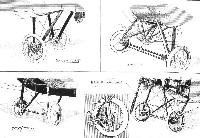 |
Журнал - Flight за 1915 г.
|
| Various "Vee"-type undercarriages constructed of wood.
|
 |
P.Lewis - British Aircraft 1809-1914 /Putnam/
|
| Sopwith Three-seater
|

